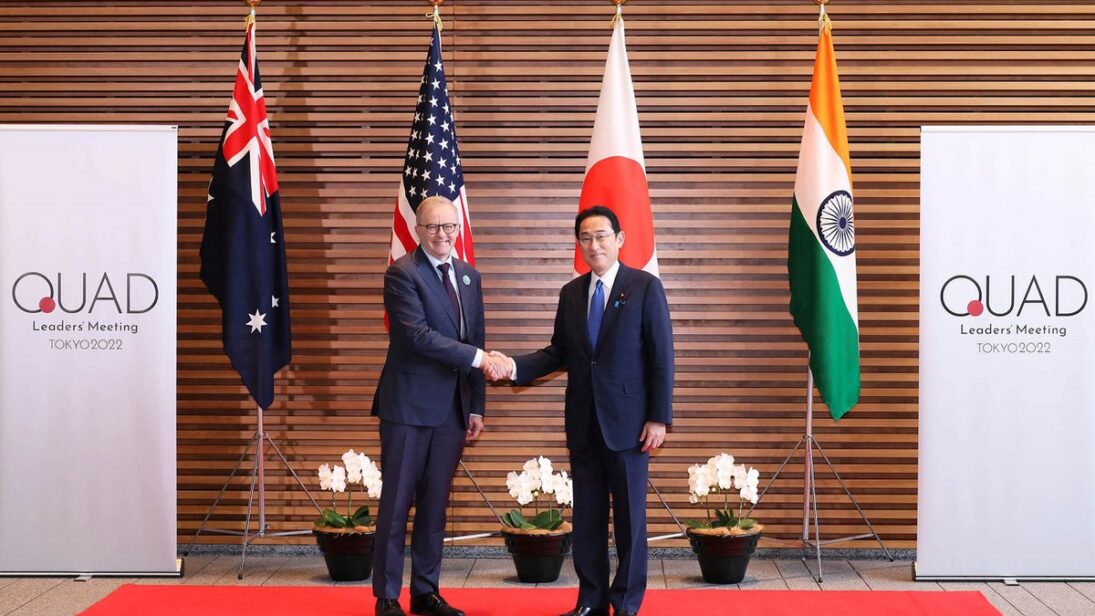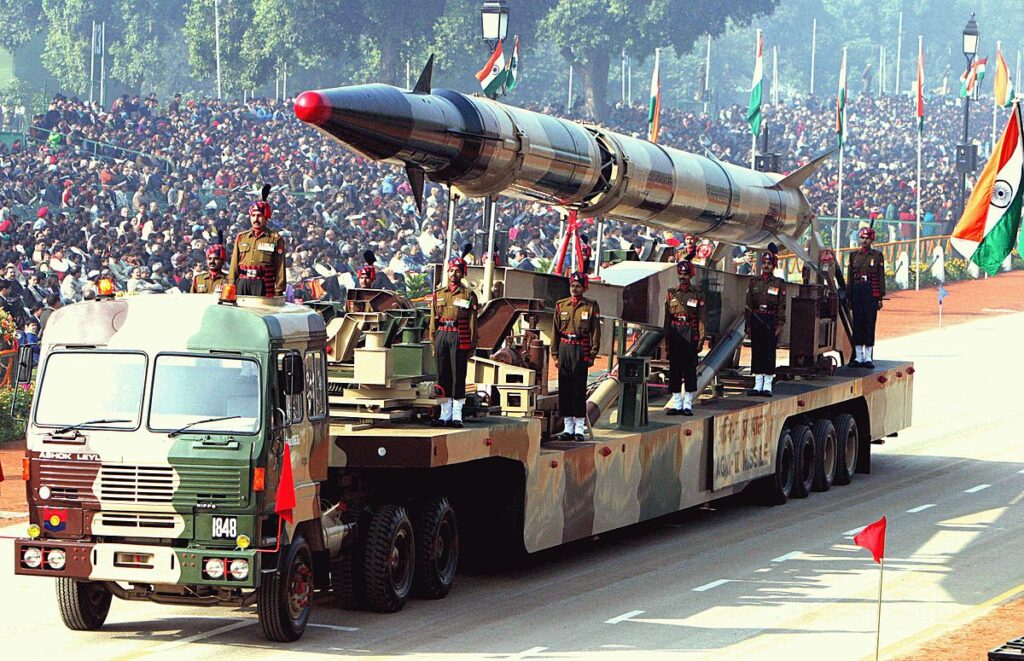
The leaders of the Quadrilateral Security Dialogue, popularly known as the Quad, have consistently reaffirmed their commitment to “the complete denuclearization of the Korean Peninsula,” first through a statement issued in Hiroshima, then at the Shangri-La Dialogue in 2023, where regional security thinkers spoke about the need to establish “guardrails” against growing nuclear threats. The Quad foreign ministers’ main concerns have been nuclear use in the ongoing Russia-Ukraine conflict, which they declared “inadmissible,” and North Korea’s provocative nuclear weapons buildup and ballistic missile launches.
To accomplish its vision of a free, open, and inclusive Indo-Pacific, the Quad has to de-risk nuclear threats more vigorously, comprehensively, and systematically. This task is urgent for several reasons. First, eight nuclear-armed countries are perpetually competing for their national interests in the region. Second, emerging sophisticated nuclear and missile technologies are blurring the conventional-nuclear binary. Third, natural disasters or cyber attacks on nuclear power plants and other experimental installations pose increased nuclear risks. Given the alarming absence of adequate forums to discuss nuclear risks amidst intensifying arms races in the Indo-Pacific, the Quad should take the lead to build and support the de-risking of nuclear threats.
A Nuclear Hotspot
The Indo-Pacific is a high-risk nuclear zone with reports of clashes between nuclear-capable states or nuclear focused alliances occurring nearly every week. Of the 12,500 global nuclear warheads estimated to exist as of 2023, nearly 12,400 are in the possession of the United States, Russia, the United Kingdom., France, China, India, Pakistan, and North Korea. All these countries assert their role in the Indo-Pacific region.
To accomplish the vision of a free, open, and inclusive Indo-Pacific, the Quad has to de-risk nuclear threats more vigorously, comprehensively, and systematically.
Relationships between the region’s eight nuclear-armed states are mostly troubled. Countries are either abandoning former nuclear arms control confidence building measures (NCBMs), or never had those mechanisms in the first place. For instance, the United States and Russia, which possess approximately 89 percent of global nuclear inventory, are currently in a state of high operational alert amidst the Ukraine crisis. Russia has been undermining critical international non-proliferation norms by assisting China in nuclear force modernization and increasing its nuclear stockpile of plutonium. Russia is also increasing nuclear pressure on Japan with belligerent nuclear rhetoric. Whereas China and India, as well as India and Pakistan, hardly have any institutionalized NCBMs between them.
The sharp expansion of Chinese nuclear arsenals is a key concern for the Quad, which fears China’s efforts to enable and aid Pyongyang and Islamabad’s nuclear capabilities in a quest to alter global power equations. This emerging Moscow-Beijing-Pyongyang-Islamabad partnership poses an unprecedented nuclear risk for the region, demanding a unified de-risking effort. Meanwhile, China and North Korea’s offensive posture against Japan, South Korea and other U.S. allies complicates Washington’s extended nuclear deterrence commitments. However, there has been an absence of coordinated measures. The AUKUS security partnership has pushed back against China, but France could assert its nuclear power in the region more strongly.
Furthermore, the proliferation of emerging technologies is a risk multiplier. Exponential growth in emerging dual-use technologies multiplies nuclear risks in major flashpoints like the Taiwan Strait, South China Sea, Korean Peninsula and Indian Ocean Region. The Indo-Pacific region will also see huge missile buildup by the 2030s. The Indian export of Brahmos missile to the Philippines, a close ally of the United States, may extend the nuclear race in the ASEAN theater. Consequently, missiles will play a primary role in early stages of armed conflicts in these areas. Moreover, the quest for acquiring undersea nuclear deterrent capabilities fuels nuclear escalation, leading to the possibility of accidents.

Along with this nuclear buildup, Southeast Asian countries such as the Philippines, Thailand, Indonesia, and Vietnam are demanding small-modular nuclear reactors (SMRs), floating nuclear power plants (FNPPs) and other dual-use military technologies, largely without proper strategic trade controls (STCs) frameworks in place. A study asserts that without envisioning and enforcing adequate security norms and risk reduction measures, these trends could pose unique nonproliferation challenges and nuclear risks. This blurring of the conventional-nuclear binary cannot be tackled without prioritizing a new nuclear risk reduction agenda.
Declining Deliberations
The Quad lacks mechanisms to assess and avoid emerging nuclear risks. Since the 1990s, multilateral institutions have failed to lay out nuclear risk-reducing regimes due to political contestations. The nuclear-armed states’ lackadaisical approach to the Nuclear Non-Proliferation Treaty (NPT) and the Treaty on the Prohibition of Nuclear Weapons (TPNW) is weakening non-proliferation and disarmament norms in the region. Amidst divisions within multilateral frameworks and the absence of nuclear-related agendas, international and regional forums lack strategies to address these challenges.
Despite being capable leading members of the Indo-Pacific, the Quad leaders are avoiding explicit discussion of nuclear security, fearing that it would increase polarization between the Quad and the Moscow-Beijing-Pyongyang-Islamabad partnership by directly antagonizing China, which has accused the Quad of being an anti-China bloc. However, the Quad’s appeasement policy only incentivizes China to further consolidate its nuclear capabilities and allies and fails to prevent nuclear risks originating from this relationship. Deliberating over nuclear de-risking strategy may be uncomfortable, but will yield better results than the Quad’s present inaction.
Expectations from the Quad
Nuclear risks are cascading, diverse, and unpredictable—yet can be managed and minimized through dialogues that offer a holistic vision and systematic plans. One step could be to create a consortium of Indo-Pacific nuclear conflict monitors to record intended and unintended nuclear risks from incidental clashes or accidents. A Quad Nuclear Risk Assessment Center could be established to analyze reported incidents and map out possible targets of nuclear strikes in the region. This center can also analyze the risks associated with false alarms and close nuclear calls.
The Quad could also assist the ASEAN countries to design strategic trade control regimes to safeguard nuclear power plants and pause the missile race.
This would enable governments to lay out adequate nuclear safety and security protocols, and empower policymakers to take informed decisions to modify vulnerable nuclear command control and communication (NC3) systems and outdated doctrines.
By providing critical assessments of nuclear risks and resources to manage these risks, the Quad could empower the ASEAN Regional Forum and the East Asia Summit to put forward an agenda of nuclear de-risking. The Quad could also assist ASEAN countries to design strategic trade control regimes to safeguard nuclear power plants and pause the missile race. More importantly, the Quad partners must bolster the recently-resolved G-20 Delhi Declaration commitments to “strengthening international cooperation to promote nuclear safety globally” by devising a prospective nuclear risk-reduction strategy.
In the long run, these efforts will be useful for the Quad and its allies to estimate the nuclear capabilities of the China-led partnership, probabilities of nuclear accidents, and potential avenues for NCBMs. Finally, such an overarching vision may inspire other states to follow similar nuclear risk reduction measures to build trust and norms of nuclear responsibility, leading to a free, open, inclusive, and rules-based Indo-Pacific.
Also Read: Emerging Missile Technologies: A New Arms Race in South Asia?
***
Click here to read this article in Urdu.
Image 1: Quad Meeting in 2022 via Wikimedia Commons.
Image 2: Agni-II missile at India’s Republic Day Parade in 2004 via Wikimedia Commons.


